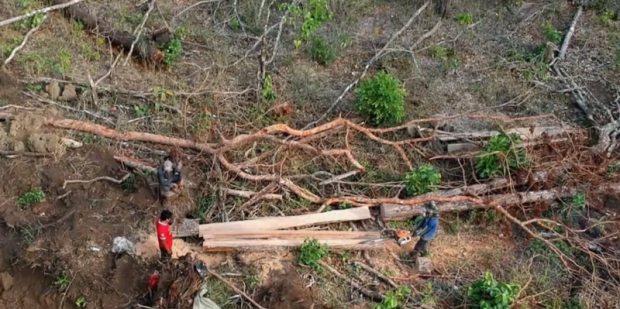This is the third post in a series based on ARTE’s documentary about FSC: “The exploitation of primary forests: Can an ecolabel stop the forest industry?”
Unfortunately, the documentary is not available on ARTE’s website after 23 October 2018, but it is available here (also in German and Spanish).
The journalists Manfred Ladwig and Thomas Reutter travel to Cambodia for the documentary. This is not their first visit to the country. Ten years ago, they reported on Chut Wutty’s campaign against illegal logging in the country.
In April 2012, Wutty was shot dead by military police.
Ten years ago, they filmed Wutty and his team taking part in jungle patrols, uncovering illegal logging operations and setting fire to the timber. In 2012, the military turned up during a patrol and attacked Wutty. Local villagers protected Wutty and he managed to leave by car.
A few weeks later, Wutty was shot dead. The documentary includes pictures of his dead body.
Ladwig and Reutter visit Chheuy Odam Reaksmey, Chut Wutty’s son and his colleagues. They continue to campaign against illegal logging, but have stopped the jungle patrols.
In January 2018, a forest protection ranger, a military police officer and a conservation worker were killed in Mondulkiri province in northeast Cambodia. They were killed by government armed forces who backed the illegal logging, apparently in retaliation for seizing chainsaws from illegal loggers. More dead bodies.
Much of Cambodia’s remaining forest is in national parks. But even then, it isn’t protected. Villagers are allowed to cut timber inside the national park, but only for their own use.
Ladwig and Reutter see collection points at the side of the road, where companies buy timber from villagers. The timber, they explain, is sold to companies, and later that timber will receive the FSC label.
They see motorbikes transporting timber along the dusty roads. Small tractors carry more wood. The amount of timber is way too much for just the local villagers own use.
The journalists follow illegally felled timber in Cambodia over the border into Vietnam.
Julian Newman of the Environmental Investigation Agency explains how the timber is transported to the Vietnamese port of Qui Nhon. The export of timber from Cambodia to Vietnam is banned under Cambodian law.
But once the timber is in Vietnam, no one asks where the timber came from.

EIA has been researching the illegal trade in timber from Laos and Cambodia since the early 1990s. EIA’s 2008 report “Borderlines: Vietnam’s Booming Furniture Industry and Timber Smuggling in the Mekong Region” found that FSC’s chain of custody certification provides no guarantee that the timber was legal.
In 2017, EIA put out a report titled, “Repeat Offender: Vietnam’s persistent trade in illegal timber”. And in 2018, EIA put out yet another report, this one titled, “Serial Offender: Vietnam’s continued imports of illegal Cambodian timber”.
ARTE’s journalists follow the Cambodian timber to Qui Nhon, a centre of Vietnam’s timber industry. They visit an FSC-certified timber yard. EIA notes that most of the timber in Qui Nhon comes from Cambodia. From Qui Nhon it is exported to Europe and the rest of the world, some of it with the FSC label.
EIA’s Julian Newman tells Ladwig and Reutter that,
“There’s also still a clique of companies that still depend on illegal timber and some of that is undoubtedly reaching markets in the West as well. When we did our work in Qui Nhon, we found a few companies that had some level of certification but were still taking illegal timber.”
Kim Carstensen, FSC’s Director General, responds as follows:
“We certainly know of illegal logging in Cambodia and also the links to Vietnam. We disassociated from a company called the Vietnam Rubber Group a couple of years ago, for that reason. So it’s certainly something that we’re aware of and it’s a very important issue.”
Vietnam Rubber Group received FSC certification for two of its rubber plantations in Vietnam. FSC disassociated from the Vietnam Rubber Group after a formal complaint from Global Witness in September 2014.
The FSC Complaints Panel found that the Vietnam Rubber Group and its subsidiaries in Cambodia “routinely ignored indigenous land claims, permitted illegal loggers on the concessions and allowed armed government-backed military police to threaten protesters.”
Disassociating from the Vietnam Rubber Group was the right thing to do. But it’s a red herring in terms of addressing the flow of illegal timber from Cambodia to Vietnam and into the FSC chain of custody.
As EIA’s recent video shows, the timber continues to come from a range of sources in Cambodia:
Nevertheless, Carstensen seems to believe that FSC has everything under control:
“We are taking action, in making sure that our supply chains, also in Cambodia, Vietnam and to the rest of the world becomes, um, checked.”
“Until then, the timber from Cambodia goes for sale to Europe. With the FSC label,” the documentary voice over comments.
This is the third post in a series based on ARTE’s documentary about FSC: “The exploitation of primary forests: Can an ecolabel stop the forest industry?”
The documentary is available here (and in German here).
